Financial freedom at 38! Entered the cryptocurrency world at 25, made 8 figures in 10 years. A bloody warning: 99% of people fail due to 'mindset,' not skills!
“At 25, I invested all my savings of 50,000 into the cryptocurrency world; at 38, I earned enough money to last a lifetime through trading cryptocurrencies, with assets exceeding 10 million. No team, no insider information, and never worked a single day—now I wake up naturally every day, walk my dog, drink tea, and watch the K-line. Worries? Nonexistent.”
But if you think this is a 'feel-good article,' you can scroll away now.
The truth I want to tell may send chills down the spines of 80% of people in the cryptocurrency world—
The fundamental reason for your losses is not poor technology!
'During the 2021 bull market, I witnessed an experienced trader accurately escape the top using the MACD golden cross strategy, yet lost all profits when bottom-fishing LUNA in the bear market; another novice who couldn't even read candlesticks just held onto BTC, their assets increased by 6 times.'The most ironic reality in the cryptocurrency world:
Those studying technical analysis often encounter black swans right after 'precise bottom fishing'
Those obsessed with news are often harvested by market makers after favorable announcements
The more desperately you operate, the more likely you are to become one of the 90% of losers
Ten years of blood and tears condensed into three iron laws (subverting cognition):
'Lying flat is more profitable than hard work'
80% of my profits come from 'playing dead' - bought ETH in 2019, sold in 2021, yielding 1200%
Frequent position changes incur enough fees to buy a BMW
'Rejecting quick wealth leads to real wealth'
Those rushing into shitcoin projects shouting for 'hundredfold coins' have grass three meters high on their graves.
I only add positions after BTC drops 30%, reduce positions when the bull market rises by 50%, slow is fast
'Your anxiety is the nourishment for the market makers'
Why does it always rise when you sell and fall when you buy?
Market makers rely on the 'fear and greed index' to harvest retail investors: when the community is buzzing about 'bottom fishing', it’s a retreat signal!
If you are experiencing these pains:
Watching the market for 12 hours a day, yet the account keeps decreasing
Sleepless after opening a position, afraid of a rise when it goes up, and afraid of a crash when it goes down
Countless times swore 'never to touch the cryptocurrency world again', yet couldn't help but go all in
Seize the core trend of 2025. The cryptographic wealth password for 2025: institutional FOMO buys up BTC ETF, RWA trillion tracks ignite, AI + DeFi revolution reconstructs wealth distribution, Solana ecosystem violently pulls the market, retail survival rule - either evolve or zero out!
Break down the core logic:
Institutions are swallowing BTC: giants like BlackRock are accumulating through ETFs, Bitcoin has become 'digital treasury bonds', $150,000 is just the starting point;
RWA (Real Asset Tokenization): Real estate, treasury bonds on-chain, traditional capital floods in, $50 billion market cap is just an appetizer;
AI + DeFi nuclear explosion: Decentralized AI agents issuing coins, the on-chain data market is rising, and hundredfold MEME coins are generated automatically by algorithms;
Solana ecosystem hegemony: DEX trading volume accounts for 74%, USDC stablecoin infusion, the new king of public chains crushes Ethereum Layer;
Policy tailwind: Trump's 'Bitcoin Strategic Reserve' is implemented, SEC regulation is loosened, 401(k) pensions enter the market to buy up;
Retail investors' life and death line: Four-year cycle invalidated, hot spots only survive for 3 months, lying flat = zero, only fast is unbroken!
Institutional funds and compliance
The popularization of Bitcoin spot ETFs and Ethereum ETFs has accelerated the entry of traditional institutions. BTC, ETH, and other mainstream coins have become core assets for institutional allocation, with long-term holding being more stable.
Improved regulation reduces systemic risk, but attention must be paid to policy dynamics to avoid crossing compliance red lines (such as trading anonymous coins banned in certain countries).
Emerging race track machine
AI + Blockchain: Decentralized AI platforms (like Bittensor) and AI-driven Meme coins (like Goatseus Maximus) may become dark horses.
RWA (Real Asset Tokenization): Treasury bonds, real estate, and other assets on-chain will attract traditional financial funds, pay attention to on-chain treasury bond projects laid out by institutions like BlackRock.
Layer 2 and cross-chain ecosystems: Ethereum Layer 2 (Arbitrum, Optimism) and Solana ecosystem (JUP, BOME) are experiencing continuous explosions due to high performance and low costs.
8. Core profit strategies and practical skills
Long-term investment (HODL)
Target recommendations: Bitcoin (BTC) and Ethereum (ETH) as 'digital gold' and smart contract infrastructure, long-term holding and staking (annualized 4%-6%) can achieve stable appreciation.
Investment strategy: Buy mainstream coins monthly with a fixed amount, averaging costs, to avoid timing risks.
Short-term and swing trading
Swing trading: Buy low and sell high based on support levels (such as daily MA30) and resistance levels (such as historical highs), combined with technical indicators like MACD, RSI to judge trends.
Arbitrage trading: Cross-platform price difference arbitrage (e.g., BTC price difference between Coinbase and Binance) or cross-chain asset arbitrage (e.g., BTC and WBTC exchange)
Early project follow-up: Pay attention to new public chains (such as Sui, Aptos) ecosystems' DeFi and GameFi projects, participate in presales or community activities.
Provide liquidity on platforms like Uniswap, Aave to earn transaction fees and token rewards, but be wary of smart contract vulnerabilities and impermanent loss risks.
Use yield aggregators (like Yearn Finance) to automate and optimize yield strategies.
9. Risk management and mindset adjustment
Position control
Do not invest more than 20% of total funds in a single project, with mainstream coins (BTC, ETH) accounting for 60% and altcoins 40% to balance risk and return.
Retain 30% cash to respond to crash bottom-fishing opportunities.
Stop-loss and take-profit
Set hard stop-loss points (e.g., exit at a 10% loss), take profits in batches (e.g., sell 50% of positions when profits reach 50%).
Avoid FOMO (fear of missing out), strictly execute plans, and refuse emotional trading.
Safety Protection
Use cold wallets to store large assets, enable 2FA verification on exchanges, and be wary of phishing links and fake airdrops.
Choose compliant platforms (like Binance, Coinbase) to reduce the risk of exit scams
Only because clinging to the classic buy-sell mantra of moving averages has almost eaten away all the profits from my positions. The principle is simple, and firmly doing this one trading system will, over time, become your ATM.
The trading system encompasses a comprehensive framework of the trader's trading philosophy, trading signals, risk management, emotional control, and more.
Trading philosophy: The trader's understanding of the market and trading objectives, such as whether to pursue trend trading, swing trading, or other specific types of trading opportunities.
Trading signals: Specific buy and sell point indications, such as signals generated through technical analysis indicators (e.g., moving averages, MACD, etc.), or information based on fundamental analysis.
Risk management: Set stop-loss points, take-profit points, and capital management strategies to ensure that losses can be controlled even in adverse market conditions.
Emotional Control: Maintain calm decision-making ability, avoiding irrational trading behavior caused by greed or fear
Execution difficulties: including overcoming psychological barriers, strictly executing established trading plans, and continuously optimizing and improving trading systems.
I want to share with you the correct usage and attention details of the million-dollar value indicator EMA for medium to long-term trading!
1. Indicator Overview
Exponential Moving Average Convergence/Divergence (MACD) is a common technical analysis tool in stock trading, proposed by Gerald Appel in the 1970s, used to assess the intensity, direction, energy, and trend cycles of stock price changes, to seize the timing for buying and selling stocks.
The MACD indicator consists of a set of curves and figures, calculated from the fast-changing and slow-changing exponential moving averages (EMA) of the stock price or index at closing time. 'Fast' refers to the EMA of a shorter period, while 'slow' refers to the EMA of a longer period, with the most commonly used being the 12-day and 26-day EMA. As stated (from Wikipedia)
Friends who often watch the market should have seen it, it looks something like this:
 2. Principle explanation
2. Principle explanation
To understand how to use MACD, we first need to understand the components of MACD.
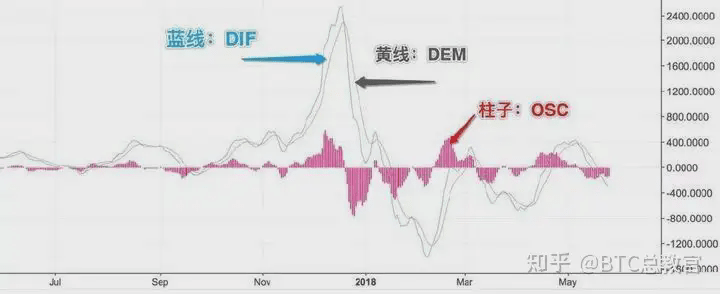
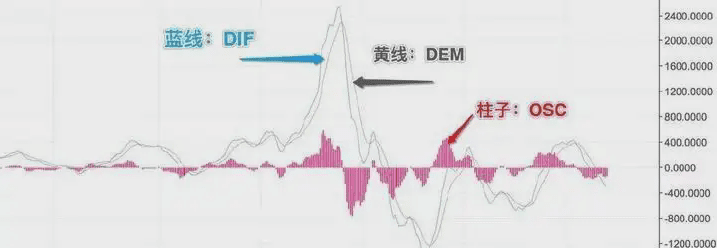 The above chart shows Bitfinex's BTC/USDT MACD on a daily basis
The above chart shows Bitfinex's BTC/USDT MACD on a daily basis
You can see that the horizontal axis represents time, and the vertical axis represents units, the graph mainly consists of three parts: blue line, yellow line, and red bars. Now let's introduce them one by one.
Blue line: DIF
The blue line is the MACD Line, also known as DIF, which indicates the speed difference between the 12-day and 26-day price moving averages, calculated as follows:

 We can roughly consider the average closing price over a period as the average holding cost of the market during that time.
We can roughly consider the average closing price over a period as the average holding cost of the market during that time.
Among them, EMA(close,12) represents the average of the closing prices for the last 12 days, and similarly, EMA(close,26) represents the average for the last 26 days. The difference between the 12-day and 26-day closing price averages gives us the DIF. From this, we can summarize what situations might occur under ideal circumstances:
1. The stock price rises rapidly over a period, with increasing gains, and the average closing price of the last 12 days exceeds the average closing price of the last 26 days, with a DIF greater than 0 and an increasing value, moving further from the 0 axis. The market's average holding cost rises and is considerable.
2. The stock price rises over a period, but the gains are decreasing, with the average of the last 12 days greater than the average of the last 26 days, with a DIF greater than 0, but the value is decreasing and moving closer to the 0 axis. The market's average holding cost rises but is minimal.
3. The stock price declines over a period, with increasing losses, the average of the last 12 days less than the average of the last 26 days, with a DIF less than 0, and the value is decreasing and moving further from the 0 axis. The market's average holding cost decreases and is considerable.
4. The stock price declines over a period, but the losses are decreasing, with the average of the last 12 days less than the average of the last 26 days, with a DIF less than 0, and the value is increasing and moving closer to the 0 axis. The market's average holding cost decreases but is minimal.
Red line: DEM
The red line is the Signal Line, also known as DEM, which is the 9-day average of the MACD Line (DIF), calculated as follows:

 This indicates the average change in holding cost over the past 9 days. Therefore, DEM always changes less than DIF and reacts slower.
This indicates the average change in holding cost over the past 9 days. Therefore, DEM always changes less than DIF and reacts slower.
Thus, we refer to DIF as the fast line and DEM as the slow line.
Bar line: OSC
The red bars represent the MACD Histogram, also known as OSC; OSC indicates the difference between DIF and DEM, with the following formula:
OSC = DIF - DEM
Sometimes for convenience, we will multiply the difference between DIF and DEM by 2, making the bars twice as high for better recognition.
OSC indicates the difference between the change in today's average holding cost and the average change in holding cost. What does this difference mean?
We can reflect the market's rising and falling trends and the strength of willingness through the size and sign of this difference. OSC can be regarded as the 'acceleration' of prices, indicating the change of potential energy.
 As shown in the figure, through OSC, we can see the changes in the market's short-term trend, thereby judging the timing for buying and selling.
As shown in the figure, through OSC, we can see the changes in the market's short-term trend, thereby judging the timing for buying and selling.
3. The two basic methods of using MACD
Next, let's understand the two most basic methods of using MACD:
Golden cross and death cross judgment methods;
Bottom divergence and top divergence judgment methods.
Golden cross and death cross
Golden crosses and death crosses often represent turning points of a trend and are very important reference indicators for buying and selling. As shown in the figure:
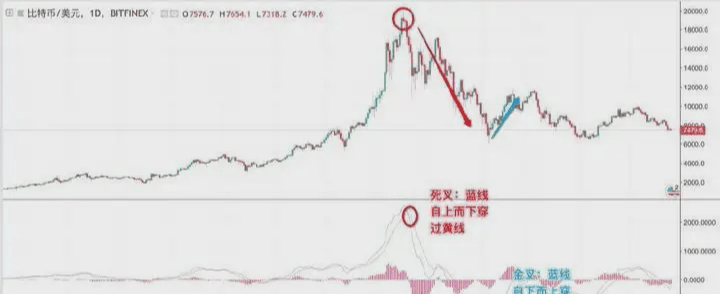 K-line and MACD comparison chart of BTC
K-line and MACD comparison chart of BTC
We look at the wave of movement after BTC stood at $20,000 in December. When the DIF crosses the DEM from top to bottom, as seen in the first circle at the lower left of the chart, the blue line crosses below the orange line, forming a death cross, and the entire market subsequently enters a downtrend. Until February 10, at the position of the second circle at the bottom of the chart, the DIF crosses the DEM from bottom to top, meaning the blue line crosses above the orange line, forming a golden cross, and the market welcomes a wave of rebound.
For death crosses, the higher the position, the greater the probability of a downward trend; similarly, for golden crosses, the lower the position, the greater the probability of an upward trend.
Therefore, we see multiple occurrences of DIF and DEM crossing or even intertwining between the two peaks, and due to insufficient height and depth, they cannot form strong buy and sell signals, often representing very short-term markets with limited guidance for trends.
In actual operations, it is essential to pay attention to the height and depth of crossing positions, combined with trading volume and candlestick charts for comprehensive judgment. So does it mean that if you see a shallower depth or lower height than before, it's not an operation? Let's take a look at the top divergence and bottom divergence judgment methods.
Bottom divergence and top divergence
1. What is the bottom divergence phenomenon? See the above chart:
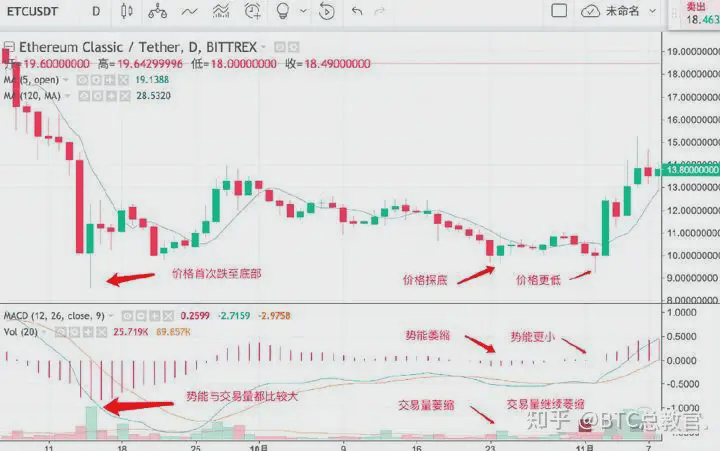 The K-line and MACD comparison chart for ETC before the bull market arrived in 2017
The K-line and MACD comparison chart for ETC before the bull market arrived in 2017
First, let's discuss the phenomenon: we see at the left arrow position of the candlestick chart, the price first falls to the bottom, showing a massive lower shadow, then enters a consolidation phase. Throughout the consolidation period, potential energy continuously shrinks, though there are some fluctuations in volume, it is still very weak, compared to the trading volume when it just hit the bottom, it shows a shrinking trend.
Pay attention to the middle and later arrow groups in the chart. After experiencing a previous period of consolidation, the main force attempts to test the bottom at the first arrow position, testing the number of uncertain chips in the market. During this trial, trading volume and potential energy both increased, but compared to before, they had severely shrunk; at the last group of arrow positions, the main force conducted a second bottom test, showing lower shadows, and compared to the first bottom test, both potential energy and volume continued to shrink.
This situation of price falling but trading volume and OSC shrinking is called bottom divergence.
Let's discuss the principles: We can imagine that when the price in the market is bottoming or peaking, it is often accompanied by fierce competition between bulls and bears, so normally there will be a significant trading volume. When the price falls to lower bottoms but the trading volume and MACD changes decrease, we believe that the market is stabilizing, and it becomes increasingly difficult for the main force to absorb chips through dumping. So at this time, the main force is often looking for opportunities to quickly pull up the market, which indicates that a bull market is likely to arrive in the near future.
Therefore, when bottom divergence occurs, the market may have reached the bottom, making it a good time to enter. (Note this!)
2. Top divergence
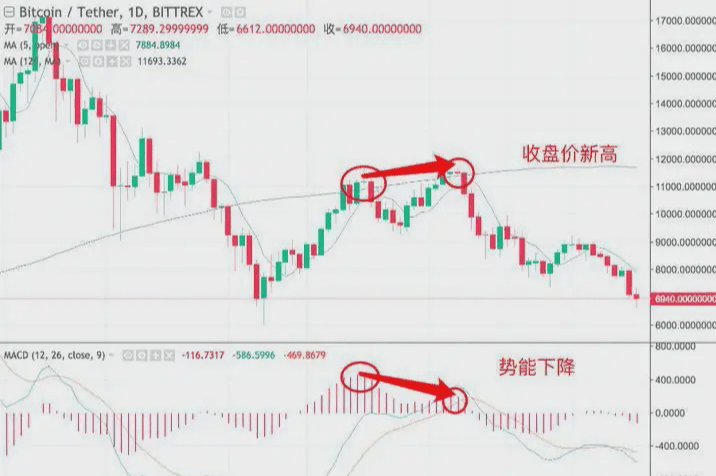 The chart shows BTC's two rebounds
The chart shows BTC's two rebounds
First, let's discuss the phenomenon: At the position of the first circle on the left, the price rebounds to 11230, followed by a wave of adjustments, forming a left high right low head-and-shoulders bottom. The price rebounds again, but unfortunately, we see that although the closing price reaches a new height, the OSC has clearly dropped compared to before, potential energy has weakened, and the bulls have been unable to continue to break through. Ultimately, the price falls all the way down, with BTC dropping below 7000, continuing the downward trend. This situation of price rising while OSC falls is called top divergence.
Let's talk about the principle: Under normal circumstances, bulls try to break through the resistance level during the first rise but fail, leading to a decline in market confidence. After a pullback, they gather strength to rise again, at which point the resistance level is stronger. Unless it’s a breakthrough market with increased volume, it’s difficult to break through the resistance level.
Therefore, we believe that when top divergence occurs, the probability of breaking through resistance significantly decreases, which is a strong bearish signal, and at this time, one should promptly stop loss and liquidate positions, and seek new entry opportunities.
4. Summary
MACD is one of the simplest and most reliable indicators, with the two most commonly used methods being:
1. Golden cross and death cross judgment methods;
2. Bottom divergence and top divergence judgment methods.
Golden cross and death cross judgment methods are lagging indicators, with weaker practicality; relatively speaking, bottom divergence and top divergence are more instructive for bottom fishing and top escaping.
Indicator introduction: EMA, moving average indicator, here only sharing medium to long-term usage, very practical and with a high accuracy rate
Applicable groups: Suitable for spot or low leverage medium to long-term trading users
Applicable targets: High liquidity, high market value, that is, large scale, high stability targets, not suitable for altcoins or small targets.
Applicable cycles: Daily line and above is best, strong stability, short-term signals should not be less than a 4-hour cycle
Indicator parameters: EMA21-55-120-200, bear or bull markets are respectively characterized by bearish arrangements (200-120-55-21 from top to bottom) or bullish arrangements (21-55-120-200 from top to bottom), initial signals are based solely on the cross signals of EMA21-55
Signal judgment: Observe the cross situation of EMA21 and EMA55 above the daily line, buy on golden crosses, sell on death crosses, and strictly execute.
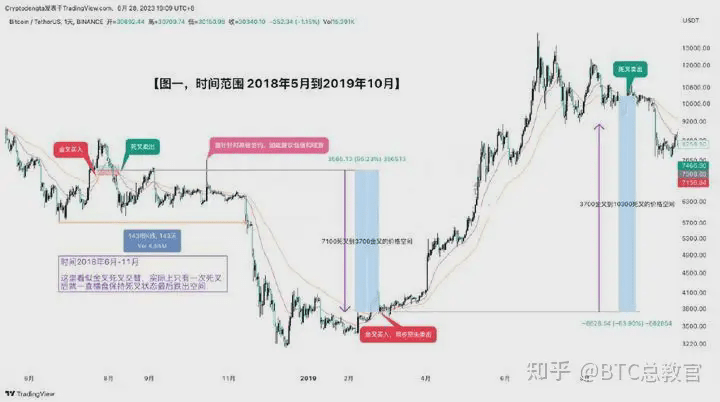
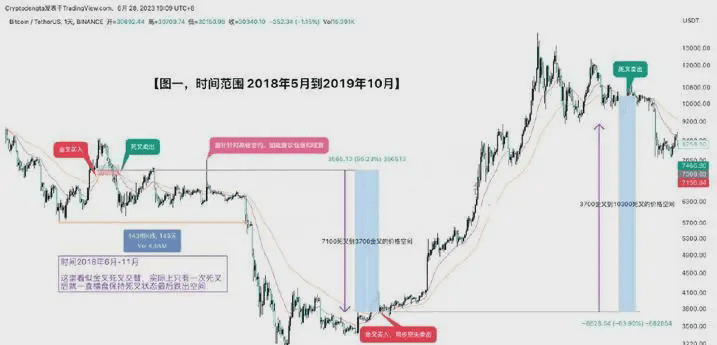 Usage methods and attention details:
Usage methods and attention details:
1. Buy: Buy when a golden cross is seen at the daily level
You can't buy at the lowest point here, but buying in the direction of the trend, profits are given to time, there are a few points that need attention regarding buying positions
During consolidation, daily golden crosses and death crosses may frequently alternate, leading to buy and sell losses, but ultimately one side will appear to continue in the medium term, so even with losses, strict execution of buy and sell signals is necessary to prevent missing trends. To reduce losses, one can judge during consolidation, such as waiting for price corrections near moving averages after forming golden cross and death cross signals, or buying in after a leading position and waiting for moving averages to rise closer to the average price.
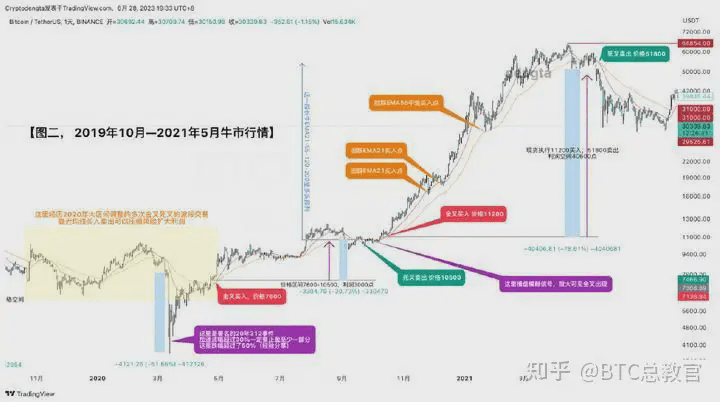
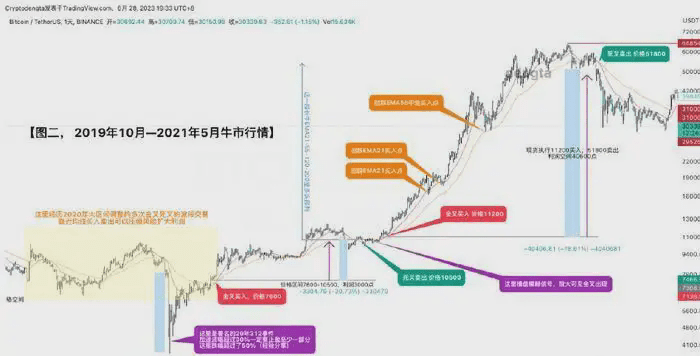 2. Selling: There are two ways to sell
2. Selling: There are two ways to sell
1. Sell when seeing a death cross above the daily line (this usually results in some profit retracement in the case of a not long-term medium trend)
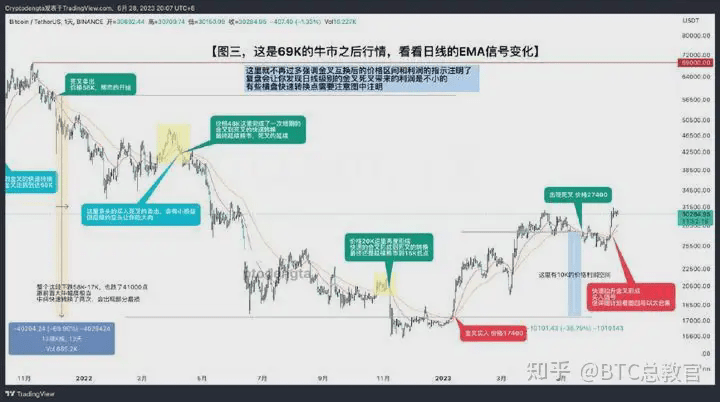
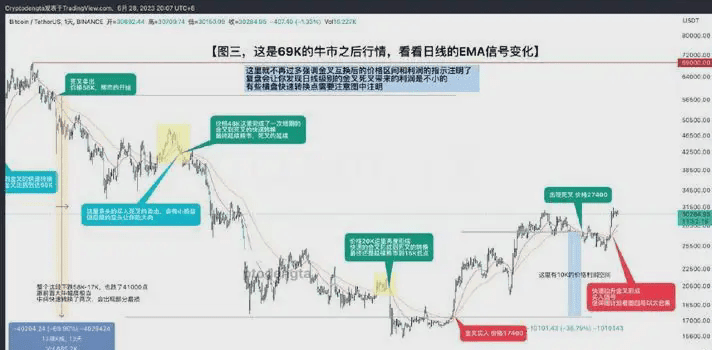 2. Sell when the set target is reached (this point can be flexibly adopted based on individual needs and plans, but the downside is that it’s easy to sell off during a bull phase)
2. Sell when the set target is reached (this point can be flexibly adopted based on individual needs and plans, but the downside is that it’s easy to sell off during a bull phase)
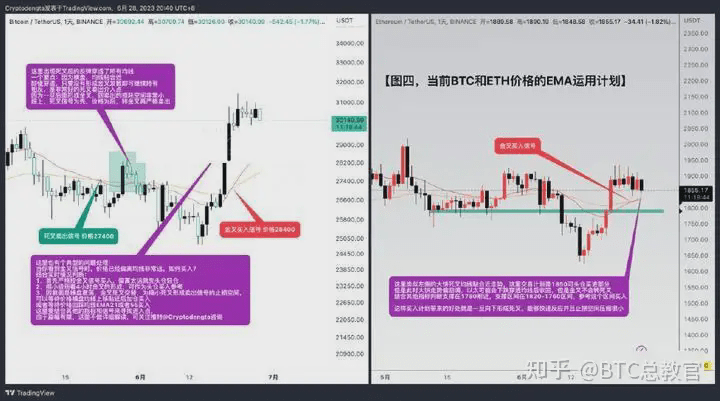
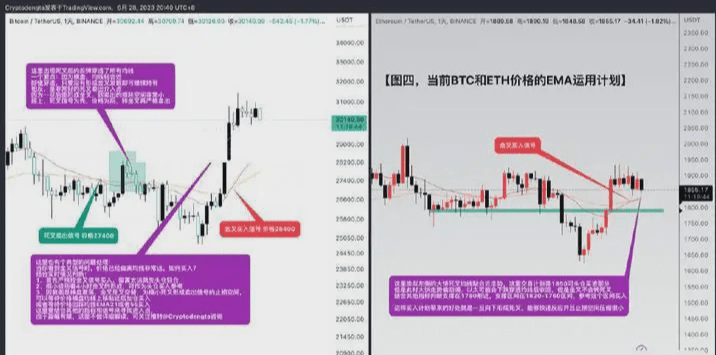 The above are all important points, must-have conditions, more details can be referenced in illustrative cases
The above are all important points, must-have conditions, more details can be referenced in illustrative cases
In summary, the EMA indicator is used to judge the medium to long-term direction, applied to profit from trends, will never buy at the lowest point or sell at the highest point, greater profits and usage can be flexibly applied
The EXPMA indicator forms a golden cross:
Every time the market turns, the coin price always catches the attention of the public in the cryptocurrency world, and each speculation point is different. The rise in coin price and the arrival of a bull market is what everyone truly hopes for.
There’s nothing much to say about the market, but it’s important to note that whether in a bull or bear market, timely stop-loss and take-profit are crucial for every investor. Avoid greed and impatience; realizing chips can determine final profits. Don’t attempt to pocket all profits; knowing when to take profits can effectively mitigate risks.
Trading must not be emotional; when in a good mood, one might go all out on high leverage, and when in a bad mood, trade recklessly without cost consideration. If so, it’s feared that all fervor may end in total failure. In investment, how much profit is secondary; preserving capital is primary. If you can’t preserve your capital, what is there to talk about locking in profits or getting rich quickly? So today, let's talk about the Exponential Moving Average (EXPMA indicator) and common candlestick technical patterns.
First, let's take a look at the EXPMA indicator, which is a trend-type indicator, weighted by exponentially decreasing moving averages. Its construction principle is to take the arithmetic average of the closing prices and analyze based on the results to judge the future trend of price changes.
Compared to MACD indicators and DMA indicators, the EXPMA indicator emphasizes the weight of the price in the current period in its calculation formula, thus overcoming the lagging signals of MACD regarding price trends. It also somewhat eliminates the premature signals of DMA in certain situations, making it a very effective analysis indicator.
So, in actual cryptocurrency trading, what are the buying and selling skills of the EXPMA indicator? First, let's look at the buying skills:
1. The EXPMA indicator forms a golden cross, price reverses upwards, trading volume increases, buy;
2. When the EXPMA indicator turns flat or upward, price crosses above the EXPMA indicator, buy when a bullish candlestick appears;
3. When the EXPMA indicator's direction is upward, price drops below the EXPMA, overshooting and reversing upward, buy when it rises by more than 4%;
4. The EXPMA indicator's direction is upward, price adjusts to confirm support, and buy when a reversal candlestick appears;
5. The EXPMA indicator's direction is downward, price moves far from the EXPMA indicator, price overshoots and reverses upward, with increased trading volume or a large reversal candlestick appears, buy.
And selling skills are just the opposite:
1. The EXPMA indicator forms a death cross, price reverses and falls, sell;
2. When the EXPMA indicator turns flat or downward, price drops below the EXPMA indicator, sell when a bearish candlestick appears;
3. When the EXPMA indicator's direction is downward, price breaks through the EXPMA, stagnates, and reverses downward, sell when the peaks decrease;
4. The EXPMA indicator's direction is downward, price rebounds to confirm its pressure, and sell when a reversal down candlestick appears;
5. The EXPMA indicator's direction is upward, price quickly rises far from the EXPMA indicator, price stagnates and reverses downward, sell.
Of course, all the techniques summarized here are just references; specific operations still need to be assessed and analyzed based on one's investment habits and focus, as the market's inefficacy and individual investor differences exist. Rigid adherence to principles or copy-pasting practices can lead to vastly different outcomes. Moreover, the EXPMA is not necessarily infallible or universally applicable. It is important to note that the golden cross buy signal we emphasize must meet the following conditions:
1. The EXPMA indicator and MACD indicator must resonate;
2. Check if the MACD indicator crosses above the 0 axis;
3. Observe whether the EXPMA indicator had formed a golden cross before crossing the 0 axis of the MACD indicator.
If all the above conditions are true, you can time the position increase; if the answer is no, it’s better to observe and wait for a better time to buy.
Risk warning: The MACD technical indicator's usage methods are for learning reference only. Technical analysis has never relied on a single indicator to judge the market. If you only use a single technical indicator to predict future market trends, the failure probability is high, so be aware of the risks.
 Having been in the cryptocurrency market for over ten years, I believe I have outperformed 90% of contract traders; I have experience with funding platforms, contracts, and arbitrage, and have also been ruthlessly harvested by market makers. I have experienced all the pitfalls the market has to offer. How can one achieve stable profits in the cryptocurrency world?
Having been in the cryptocurrency market for over ten years, I believe I have outperformed 90% of contract traders; I have experience with funding platforms, contracts, and arbitrage, and have also been ruthlessly harvested by market makers. I have experienced all the pitfalls the market has to offer. How can one achieve stable profits in the cryptocurrency world?
First learn to 'not lose money' before discussing making money!
'In the cryptocurrency world, only those who survive have the right to talk about profits.' Newcomers always want to gamble on hundredfold coins, while the veterans study 'how to lose slowly.'
Stop-loss is a lifesaver: If a single loss exceeds 3% of the principal, cut the position immediately; don’t ask 'what if it rebounds?' - in 2021, Moon fell from $100 to $0.0001; how many people lost their pants because of 'value investing'.
Stay away from leverage: Chen Xiao's story of using 20x leverage from 70 million to 4 million is a bloody lesson. Remember Ding Hongbo's formula: leverage x liquidation probability = 100%.
Only earn money within your understanding; other fluctuations have nothing to do with you
Before ORDI rose 10 times in 2023, I studied the Ordinals protocol for three months, even reviewing the GitHub records of Bitcoin core developers. Meanwhile, those who called me 'fool' didn't even understand the difference between NFT and BRC-20 and dared to go all in.
Establish a circle of competence: only engage with projects you understand (like BTC/ETH), with altcoin positions not exceeding 10%.
Reject FOMO: When others are shouting to buy, you check the white paper; when others go all in, you calculate the risk-reward ratio. 3. Fund management is mathematics, emotional management is philosophy
Position allocation: Take profit strategy:
Sell half after a 50% rise, sell another half after a 100% rise
Hold the base position until the end of the bull market (refer to Tony's 'trend does not break, do not leave the market' principle)
Total position ≤ 30% (leave 70% cash to wait for crashes to bottom-fish)
Single coin ≤ 5% (to prevent being wiped out by a memecoin)
Counterexample: When Dogecoin skyrocketed in 2021, someone turned a $100,000 principal into $5 million without taking profits, only to drop back to $200,000 and cry about leaving the market.
4. Replace emotion with rules, replace luck with systems
Create a trading checklist:
Only buy coins in the top 50 by market cap
Only build positions in batches after a 10% drop
Stop trading for a week after three consecutive losses
Compound interest is the only holy grail, but 90% of people misunderstand it
Ding Hongbo calculated: annualized 30%, 13.78 times in 10 years; annualized 50%, 57.66 times in 10 years. But the premise is:
Maximum drawdown ≤ 15% (otherwise, earning 10 times won't cover 1 loss)
Only use profits to increase positions (the principal must remain untouched)
Hoard coins in bear markets, sell coins in bull markets (counterintuitive approach)
A cautionary tale: How many people relied on DeFi mining for an annualized 500% from 2020 to 2022, only to give it all back to shitcoin projects in 2023.
Let me say something offending:
The secret to stable profits in the cryptocurrency world is just eight words - 'No greed, no leverage, no show-off.'
Don't be greedy: Is a threefold return over three years not appealing? You deserve to be a retail investor.
No leverage: opening a leveraged position is momentarily exciting, but liquidation is a disaster.
Don’t show off: If you made money, secretly buy ribs, don’t flaunt screenshots on Weibo.
In summary: There is no stable path to getting rich in the cryptocurrency world, only living stably. Tony has long revealed the truth: 'Those who live long will eventually get rich, while those who get rich may not live long.'
I am Fan Fan, focusing on the cryptocurrency world for many years, sharing useful and diverse professional knowledge. For those destined to meet, who else can help you if money doesn’t? Follow Fan Fan, I'll take you to unlock the things inside the circle, clearing the misty cryptocurrency market. I hope our encounter can be filled with kindness and rewards!$BTC $ETH #现货黄金创历史新高 #山寨季将至?